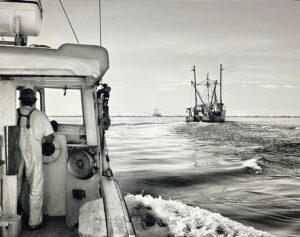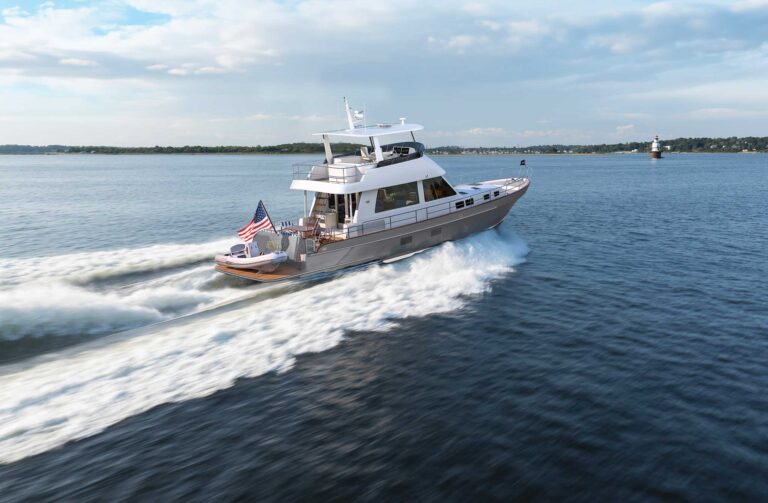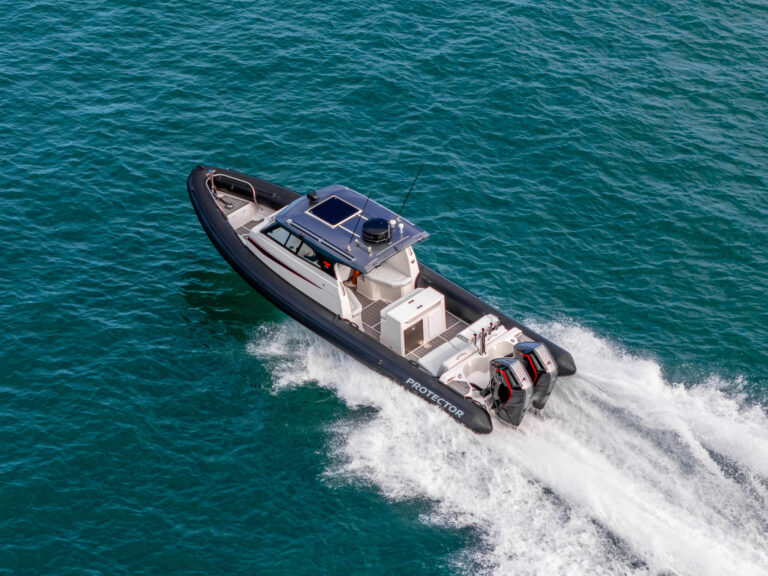New Jersey anglers are challenging the U.S. Army Corps of Engineers over a beach renourishment plan, the latest battle in what has become a worldwide dispute about the use of sand as a natural resource.

The New Jersey plan would mine sand from fishing grounds to build a 14-mile line of protective dunes seaward of communities destroyed by Hurricane Sandy. “It’s a massive project,” says Ken Warchal, vice president of the Jersey Coast Anglers Association. “The dunes will be 25 feet high.”
The project identifies five sea mounts where dredges would mine almost 10 million cubic yards of sand to build a line of dunes from Manasquan Inlet south to Barnegat Inlet. Over the next 50 years, the dredges would dig another 18 million cubic yards from the sites for quadrennial dune renourishment. The half-billion-dollar project’s purpose is damage reduction for beach communities still rebuilding with help from the federal government after the devastating 2012 storm.
Two of the sea mounts are designated prime fishing grounds in New Jersey’s Coastal Zone Management Rules. “We’re not against the dune project,” Warchal says. “We just want them to take sand from somewhere else.”
“These are historical fishing grounds. They’ve been around for years,” says John Toth, JCAA’s president. “Anglers were not given a chance to weigh in on this.” Nor were commercial fishermen, he says. “They’re upset about this, too.”
JCAA’s concerns are about two sites: a 350-acre sand mound just inshore of the Axel Carlson Reef and a 1,700-acre site, Manasquan Ridge, located in federal waters and known for its flounder fishery.
The mounds are habitat for eels and other species that attract predator fish. “If the habitat is destroyed, it destroys the fishing — commercial and recreational,” Toth says.
The Big-Picture Problem
The clash over how to use the nation’s inshore waters is getting more contentious with the growing demand for sand and for inshore sites to mine it. “The rate of [shoreline] erosion nationally has been increasing over the last several decades,” says S. Jeffress Williams, a coastal marine geologist with 40 years of research experience with the U.S. Geological Survey. “We’re in a cycle of increased storm activity. We’re seeing an acceleration of sea level rise — up to 50 percent over the last 20 years — and that will continue to rise and increase in the decades ahead.”
Widespread construction of seawalls, groins and jetties — “for legitimate purposes,” Williams says, mainly to protect shoreline from erosion — has disrupted natural sand transfers along the coast, causing even more erosion and more demand for sand for beach renourishment.
Draft plans released earlier this year for Mid-Atlantic and Northeast states try to bring some order to the scramble for use of our ocean waters and bottoms out to 200 nautical miles. Those plans also note the growing demand for sand and the conflict between fishermen and communities that want the sand to maintain their beaches and tourism economies. The fishermen — recreational and commercial — see beach towns’ voracious appetite for sand as a threat to fish habitats, and to their own livelihoods and recreation.
Martha’s Vineyard, Massachusetts, which takes fishing seriously, became a battleground over sand mining last year when anglers and commercial fishermen joined forces at hearings on the state’s updated Ocean Management Plan. That plan showed a swath of Vineyard Sound — a productive fish and whelk habitat — as a source of sand to renourish more than a dozen beaches on Martha’s Vineyard and Cape Cod’s south shore. Fishermen harvest fluke, winter flounder, bluefish, striped bass, bonito, scup, sea bass, mussels, whelk, sea clams and ocean quahogs from Vineyard Sound.
“We are opposed to sand mining,” says Chilmark Selectman Warren Doty, who is also a member of the Martha’s Vineyard Fishermen’s Preservation Trust. “It is large-scale mining of the bottom, and it disrupts benthic populations.”
Dredges scour “thousands and thousands” of cubic yards of sand from swaths 200 yards or more in length, he says. “Then they put it on a beach where it’s going to erode anyway when the next storm comes. There’s not a future in that.”
In a 2014 letter to the Massachusetts Coastal Zone Management director, Chilmark Board of Selectmen Chairman William Rossi wrote about sand mining:

“The top 6 inches of mud and sand on the ocean floor contain thousands of small organisms (sea worms, shrimp, tiny shellfish, fish eggs, etc.) that are all part of the base of the food chain in our waters. Juvenile fish such as winter flounder scour the bottom and feed all day long on these small creatures. Our local channel whelks (conchs) graze along the bottom and lay their eggs in long egg sacs that they attach to the sandy bottom. Dredging up this bottom sand would disrupt and destroy all the living creatures that we depend on for a healthy marine environment.”
The issue drove a temporary wedge between Chilmark and Oak Bluffs, a Vineyard town in need of sand for its eroded beaches. Oak Bluffs advocated for sand mining but backed off and called for more careful study of mining sites to ensure operations don’t hurt fishing. Vineyard Sound remains a “potential sand source” in the ocean management plan, but Doty says town ordinances require any proposal for sand mining in its waters to come before the Chilmark Planning Board first.
“It’s controversial because there are people who live on the beach,” Doty says. “Naturally, they want sand on their beach. They want to protect their homes and real estate investments, but you can only slow down Mother Nature for so long.”
Worldwide Implications
A March 2014 United Nations report states that sand and gravel mining worldwide accounts for the largest volume — 68 to 85 percent — of solid material extracted globally. The volume of sand and gravel mined is increasing faster than any other material, the U.N. states, and because sand and gravel are formed over thousands of years through erosive processes, they are being mined at a far greater rate than their renewal.
If sand and gravel were used mainly for shoreline renewal, the material would get back into circulation quickly enough, but 70 to 75 percent is used to make cement for buildings and roads. The material also is mined for production of glass, aeronautics and electronics. The report states that inland sand sources are drying up, and that because desert sand is too finely ground to use in cement (it doesn’t have edges that enable it to bind) or shoreline renourishment (it blows away), the only alternative source is the ocean.
“Geological studies show that near-shore [deposits] of high-quality sand are very limited,” Williams says. And once depleted, those deposits aren’t replenished, on the East Coast anyway.
Rivers drained enormous land areas directly into the ocean in eons past before the great East Coast estuaries — the Hudson River, Chesapeake and Delaware bays, Pamlico and Albemarle sounds — were formed. Now, he says, the sand gets trapped in the estuaries before it ever gets to the ocean and the beaches. “When you dredge and remove sand, it’s not replaced,” Williams says. “It’s not a renewable resource.”
Tourism-dependent Miami-Dade County in Florida has exhausted its inshore sources of sand in repeated (33 total) beach renourishments during the past 35 years, so now the Corps of Engineers is looking to dredge sites 80 and 120 miles offshore, off Martin and St. Lucie counties, to replenish a 9.4-mile stretch of beach from Sunny Isles to Government Cut, including Miami Beach.
Erosion along that famous stretch of beach is severe, yet the response of Martin and St. Lucie county residents to the proposal for Miami Beach to take their sand has been sharp. “Take ‘our sand.’ HELL NO!” Anthony Dorshall wrote in a September 2015 email to the Corps of Engineers after hearings on the replenishment plan. “This sand is not available. It is ‘in trust’ for our children’s children to be used for Treasure Coast beach renourishment. Borrow our sand, that is insulting to our intelligence. … Usable sand is a diminishing resource which should be preserved. … Investors in Miami Beach made their investment, so why should the Treasure Coast be obligated to risk their future to bail them out?”
“The next 50 to 100 years is going to be very different than the last 100 years,” Williams says. “There’s going to be increased erosion and increased land loss, increased pressure to do beach renourishment, more and more conflict over where the sand is going to come from. These issues are going to increase in the years ahead.”

In California, sand mining in San Francisco Bay and on the beach of Monterey Bay has come under fire for causing erosion of nearby beaches. In November 2015, the California Court of Appeal in San Francisco ruled that the California Lands Commission must pare by a minimum 30 percent the amount of sand it allows companies to mine in the bay, and fund studies to see whether more cutbacks are warranted to stem coastal erosion.
The U.S. Geological Survey, which has been studying beach erosion on San Francisco’s outer coast, has concluded that the “loss of sediment through dredging and sand mining in the bay is having an impact on the coast of San Francisco outside the bay, which has the fastest erosion rate on the West Coast,” says Ian Wren, staff scientist for San Francisco Baykeeper, which brought the suit. He says researchers also suspect that suction dredges are capturing and killing juvenile Dungeness crab, which hatch and grow in the bay.
Meanwhile, on Monterey Bay, the Lands Commission is negotiating with Cemex, the world’s largest cement company, to shut down this country’s last beach-mining operation, at Marina, California. Cemex is believed to mine 200,000 cubic yards of sand a year from the beach, causing a net coastal erosion of 7 feet a year from Monterey to the Salinas River, according to a 2015 study by retired coastal engineer Edward Thornton.
“They’re mining right on the beach, very close to Monterey Bay National Marine Sanctuary,” Wren says. “This has been a point of controversy for decades.”
Profligate use of sand is common. “The Palm Jumeirah, an artificial set of sand islands [in Dubai, United Arab Emirates], required 186.5 million cubic meters — 385 million tons — of sand and 10 million cubic meters of rock, and cost $12 billion,” the U.N. report states. A second project, The World, also in Dubai, involved construction of 300 artificial islands and consumed 450 million tons of sand. With all of its own marine sand resources having been mined, Dubai imported sand from Australia to finish the projects, according to the U.N.
Such is the demand for sand that the U.N. reports a brisk illegal trade in it, in India and Morocco especially. “In Morocco, half [its] sand — 10 million cubic meters a year — comes from illegal coastal sand mining,” the U.N. states. “Sand smugglers have transformed a large beach into a rocky landscape. … Sand is often removed from beaches to build hotels, roads and other tourism-related infrastructure. In some locations, continued construction is likely to lead to … destruction of the main natural attraction for visitors — beaches themselves.”
A Challenging Future

Williams says a time is coming when demand for sand will be so great, supplies will be so depleted and the cost will be so high that renewing eroded beaches year after year will no longer be economical. He says a reasonable price for sand — based primarily on transportation costs — is $15 to $30 a cubic yard. “Three years ago, Honolulu paid $115 a cubic yard for sand,” he says, “an astronomical price.”
“Afghanistan and Egypt have huge supplies of sand,” Williams adds. “But is it cost-effective to fill a freighter with sand to renourish a beach in the United States?” Williams and others say that as sea levels rise and shorelines erode faster, beach communities will have to retreat from the water’s edge instead of trying to push the water back with another renourishment project.
“Today … 75 to 90 percent of the world’s natural sand beaches are disappearing, due partly to rising sea levels and increased storm action, but also to massive erosion caused by the human development of shores,” historian John R. Gillis, author of The Human Shore: Seacoasts in History, wrote in a November 2014 op-ed in The New York Times. “Many low-lying barrier islands are already submerged. Yet the extent of this global crisis is obscured because so-called beach nourishment projects attempt to hold sand in place and repair the damage [from winter storms] by the time summer people return, creating the illusion of an eternal shore.”
Gillis says, sooner rather than later, retreat from an eroding shoreline must be the better part of valor. Restoring wetlands can slow the water’s advance, he says, but piling more sand onto the beach in front of a home or business to protect it from the next big storm is ultimately futile — and it will become increasingly expensive.
Even with a fresh load of sand, he says, “Your [property ’s] chance of surviving the next big one is very, very small.”
This article originally appeared in the November 2016 issue.










